3D Printing Statistics By Market Size, Usage and Facts (2025)

Updated · Oct 20, 2025

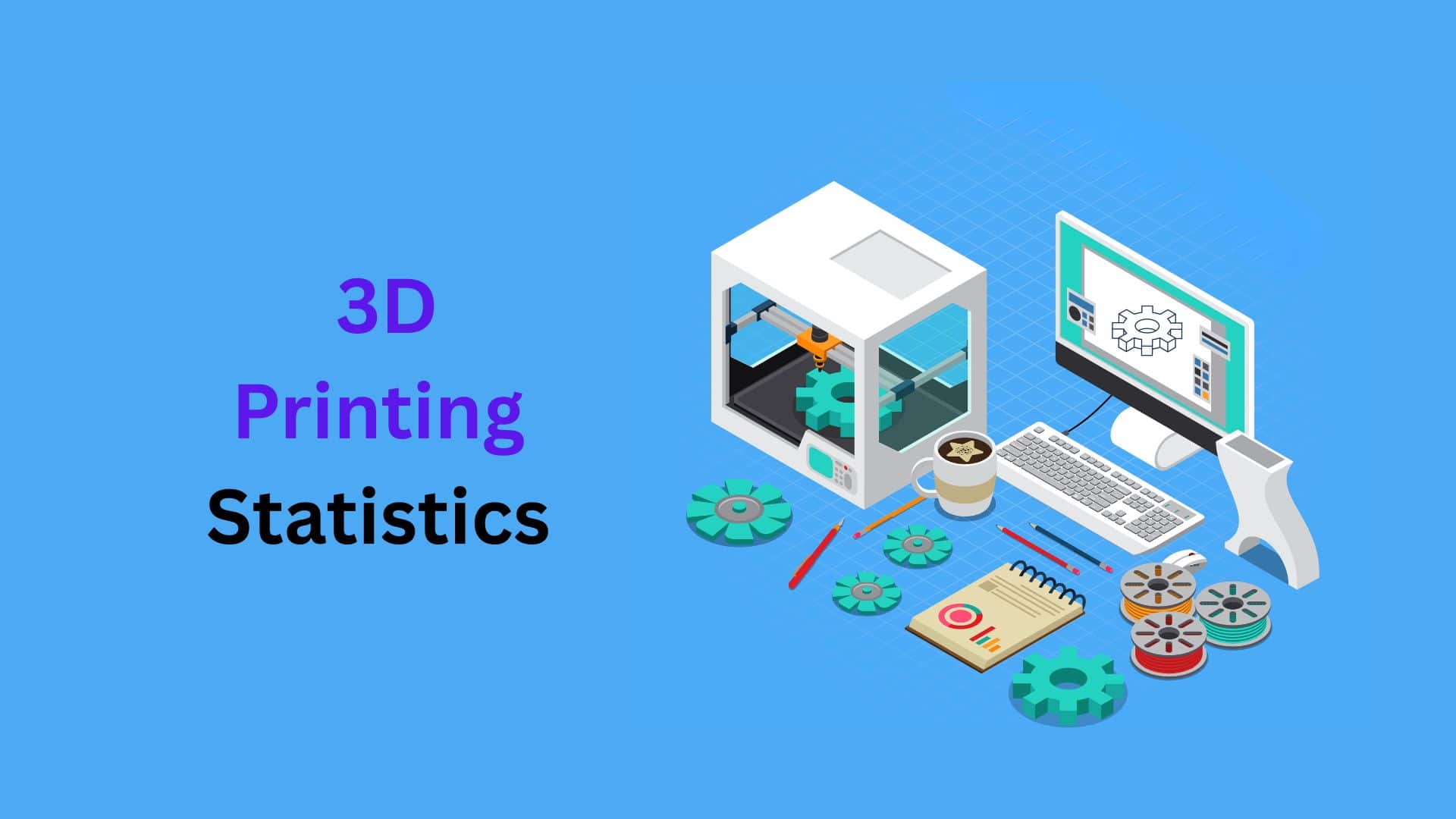
WHAT WE HAVE ON THIS PAGE
- Introduction
- Editor’s Choice
- Evolution of 3D Printing
- 3D Printing Technology Statistics
- 3D Printing Usage Statistics
- 3D Printing Market Size
- General 3D Printing Statistics
- 3D Printing Use Cases
- 3D Printing in Medical Implants
- Adoption by Industry Vertical
- Automotive 3D Printing Statistics
- 3D Printing in Dental Statistics
- Major Challenges and Restraints in 3D Printing
- Recent Developments and Industry Shifts
- Conclusion
Introduction
3D Printing Statistics: 3D printing is a way to make solid objects directly from a digital design by building them layer by layer. A printer reads a 3D file and lays down thin slices of material, such as plastic, resin, metal powder, or even concrete, until the shape is complete. Because material is added only where needed, waste is reduced and complex shapes are easy to produce.
Designers can make prototypes quickly, repair parts on demand, and customize items for each person. The process is used in healthcare, aerospace, automotive, education, and art, turning ideas on a screen into real, useful parts worldwide. Companies are leveraging it to cut product development cycles, localize supply chains, and manufacture highly customized items that traditional methods simply can’t touch. I’d like to show you some interesting facts and figures, discussing a more in-depth analysis of 3D printing statistics. These data show clear, aggressive growth. Let’s discuss it one by one.
Editor’s Choice
- The global 3D Printing market size is expected to grow from approximately $24.4 billion in 2024 to as much as $149.9 billion by 2035, reflecting a Compound Annual Growth Rate (CAGR) of around 19% to 20.4%.
- The industry is poised for rapid expansion, with some analyses forecasting a robust CAGR of 24.4% for the core AM industry (hardware, materials, and services) between 2024 and 2034.
- North America holds the largest current market share, accounting for an estimated 32% to 41% of the global 3D printing revenue in 2024, driven by its advanced aerospace and defense industries.
- Asia Pacific is forecast to be the fastest-growing regional market, with some projections showing a CAGR of 7%, fueled by rapid industrialization and manufacturing adoption.
- While prototyping remains the largest single application, generating about 56% to 70% of current application income.
- The Metal segment is the largest material category, accounting for over 51% of the 3D printer material revenue in 2024.
- The Ceramic AM segment, though small in total revenue, recorded the highest year-on-year growth among all material types in 2024.
- Industrial 3D printers dominate the revenue landscape, generating about 66% to 71% of the total printer revenue in 2024, while desktop 3D printers are the fastest-growing segment by units shipped.
- The aerospace 3D printing market is expected to grow at a CAGR of over 20% through 2032, driven by the critical need for lightweight, high-performance parts.
- 3D printing can result in significant component weight reduction. For example, the adoption of 3D-printed fuel nozzles in an Airbus engine led to a 255 kg weight reduction per aircraft.
- The additive nature of the technology drastically cuts down on material waste; 3D printing has the potential to reduce material waste by up to 95% compared to traditional subtractive manufacturing.
Evolution of 3D Printing
- The foundational year of 1981 saw the development of the first known 3D printer, the Solid Concept 1.
- In 1984, Charles Hull filed the patent for Stereolithography (SLA), arguably the first truly practical 3D printing technology.
- Just eight years later, in 1992, the technology became commercialized with the release of the SLA-250 by 3D Systems.
- A major shift towards democratization began in 2005 with the launch of the RepRap Project, which introduced the first self-replicating 3D printer design under an open-source license.
- The late 2000s saw the emergence of metal 3D printing systems like Electron Beam Melting (EBM), which was commercialized by Arcam.
- The year 2009 was pivotal, witnessing the launch of Thingiverse, a platform for sharing digital design files that provided the ecosystem necessary to support the growing number of consumer-grade desktop 3D printing users.
- By the early 2010s, the first fully 3D-printed functional objects, like the articulated bikini and the first precious metal objects, were created.
| 1984 | SLA Patent Filed (Charles Hull) | Foundation for over 37.5% of the dental 3D printer market technology today. |
| 1992 | First Commercial 3D Printer (SLA-250) |
Initiated the industrial market, setting the stage for industrial machines that now account for 76.5% of printer revenue. |
|
2005 |
RepRap Project Launch | Directly led to the massive drop in desktop printer costs, increasing consumer shipments by ~15% year-over-year in certain periods. |
| Late 2000s | Commercial Metal Systems |
Paved the way for metal materials to capture a 60.50% share in the aerospace market by 2024. |
3D Printing Technology Statistics
- The most widely used 3D printing method is fused deposition modeling, also called fused filament fabrication, and about 71% of companies that use it run the process in-house.
- Selective laser sintering ranks second in preference, and the largest share of its users, about 42%, rely on outside service providers.
- The market for stereolithography 3D printing is projected to grow at a compound annual growth rate of 19.27% and to reach US$6.746 billion by 2028.
- A share of 43% of respondents believe that 3D printing will help housing construction advance significantly.
- An estimated 2.2 million 3D printers have been supplied to customers worldwide.
- Between one and two million people are currently using 3D printers around the globe.
- In the United Kingdom, about 168,000 3D printers are installed.
- A majority of 69% of businesses report that producing complex shapes is the main benefit of 3D printing.
- A share of 77% of respondents expect the strongest impact of 3D printing to be in the medical field.
- Global 3D printer sales in the first half of 2024 are estimated at around 2.152 million units.
- For the full year 2024, worldwide 3D printer sales are expected to exceed 4.5 million units.
3D Printing Usage Statistics
- A majority of companies, over 68%, use 3D printing for prototyping and pre-series production, because it shortens design cycles and reduces trial costs.
- Only 5% of 3D printing investment is directed to buying new equipment and machines, indicating that many firms prioritize materials, software, and process integration.
- Most adopters, 81%, report satisfaction with their 3D printing strategy and intend to continue using it in the coming years.
- In the first half of 2024, China shipped 680,000 3D printers to the United States, accounting for 37.2% of its total 3D printer exports.
- Germany ranked second with 360,000 exported units, while the Netherlands, Canada, the United Kingdom, Brazil, Australia, South Korea, Japan, Russia, and Austria formed other notable destinations.
- Around 40% of businesses apply 3D printing to make functional parts that go into real-world use.
- About 26% of companies use 3D printing to manufacture tools such as jigs, fixtures, and molds.
- Finished consumer products are produced with 3D printing by 27% of businesses, reflecting growing end-use adoption.
- The 3D food segment is projected to reach $406.31 million by 2025, as niche dining and customized nutrition gain traction.
- The molds and tooling segment is expected to expand to $20 billion by 2030, driven by faster turnaround and lower tooling lead times.
- A wide range of materials can be printed, including polymers, resins, metals, cement, and ceramic-like composites; even foods such as chocolate and vegetable purees can be additively manufactured.
- Among companies making significant 3D printing investments, 18% report use for mass production, 49% for large-series runs, and 70% for small-series batches.
- Large-scale consumer examples exist; for instance, Adidas has produced running shoes with 3D-printed midsoles at volume.
- Using more additive manufacturing can reduce material waste by up to 95%, due to layer-by-layer deposition.
- A circular approach is gaining importance, with 63% of organizations exploring ways to recycle or re-use 3D-printed parts.
3D Printing Market Size
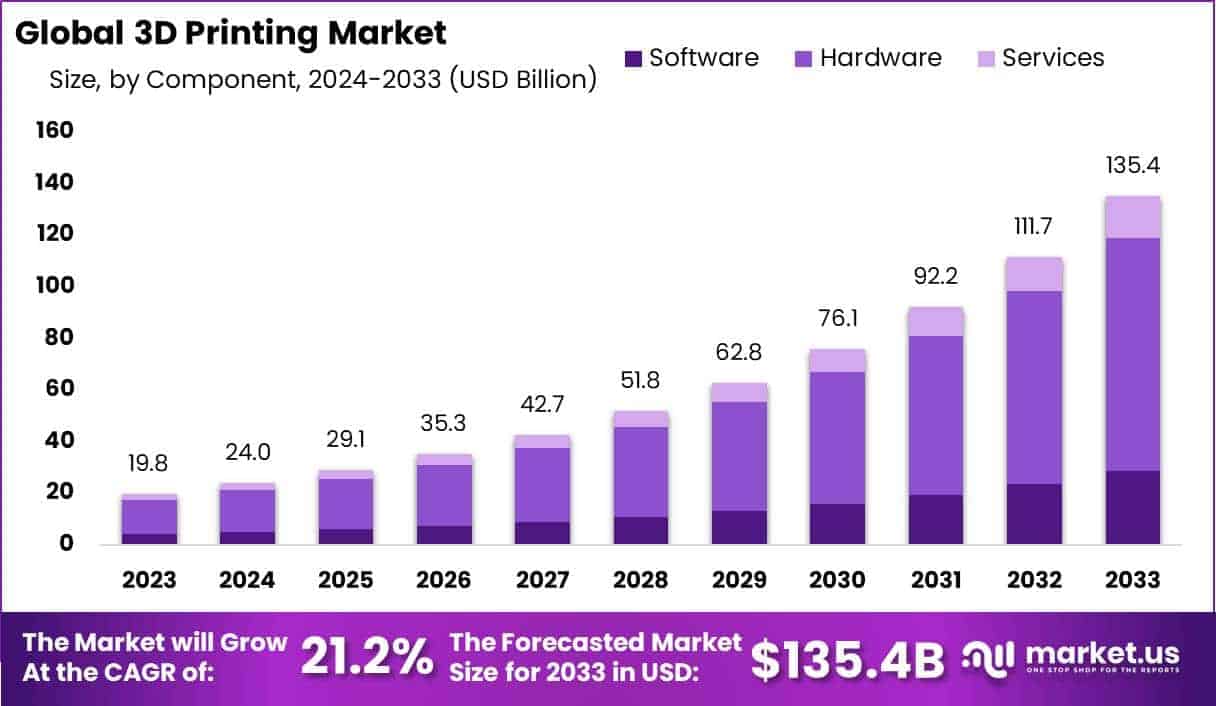
(Source: market.us)
- The global 3D printing market is projected to reach USD 135.4 billion by 2033, rising from USD 19.8 billion in 2023 at a 21.2% CAGR during 2024 to 2033.
- Annual savings in construction from 3D printing are expected to reach USD 20 billion by 2025, indicating strong cost benefits for large projects.
- Germany accounts for 37% of Europe’s 3D printing consumption, making it the region’s largest adopter.
- Educational use is widespread, as 47% of schools and universities globally report having 3D printers in their programs.
- Typical 3D printer prices range from USD 200 to USD 10,000, depending on build quality and performance needs.
- The United States leads individual country markets with USD 3.1 billion in value, representing 22% of global demand.
- Europe hosts 52% of all 3D printing businesses, reflecting a dense supplier and service ecosystem.
- The United Kingdom’s market is estimated at £468 million, ranking second in Europe and fifth worldwide by size.
- By 2030, the global market is expected to grow at 20.8% annually to about USD 62.76 billion or £48.88 billion, showing continued momentum mid decade.
- The UK market is anticipated to reach £685 million by 2026, expanding at roughly 10% CAGR.
- User sentiment is positive, as 61% of 3D printer users plan to increase spending, while 36% expect to keep spending steady.
- Average annual customer spending exceeds £8,000, and 23% of users report spending near £80,000, highlighting varied investment levels.
- Hardware held a dominant position in 2023 with more than 67% share, reflecting strong demand for printers and related equipment.
- Industrial 3D printers led in 2023 with over 75% share, indicating that enterprise use remains the primary revenue driver.
- Stereolithography captured more than 11% share in 2023, confirming steady adoption of resin-based processes.
- Prototyping represented over 54% share in 2023, showing that design validation and rapid iteration remain core uses.
- Automotive commanded more than 61% share within industrial applications in 2023, driven by tooling, fixtures, and lightweight parts.
- Metal materials led in 2023 with more than 53% share, pointing to growing demand for durable, end-use components.
- North America held over 35% share in 2023 with revenues of USD 6.9 billion, supported by strong industrial and R&D activity.
General 3D Printing Statistics
- North America held the largest regional position in 2022, accounting for over 30% of global market activity.
- The United States was the single biggest country market, reaching $3.1 billion or 22% of the total.
- Europe hosted 52% of all companies operating in 3D printing.
- Budget limits were cited by 33% of respondents as the main hurdle to wider adoption.
- The United Kingdom’s market size stood at £468 million, ranking second in Europe and fifth worldwide.
- By 2030, the global market is expected to expand at 20.8% annually to about $62.76 billion (£48.88 billion).
- By 2026, the UK market is projected to reach £685 million, reflecting a CAGR near 10%.
- 22% of users already apply 3D printing to cut manufacturing waste, and 38% expect stronger gains in sustainability and recyclability over the next 3 to 5 years.
- The 3D printing materials segment is projected to be worth $6.6 billion in 2033, according to Future Market Insights.
- 61% of users plan to increase their spending on 3D printing, while 36% expect to keep spending at the current level.
- Annual customer spending commonly exceeds £8,000, and 23% report spending close to £80,000.
- Cost remains the top barrier to more frequent use for 55% of surveyed consumers.
- German suppliers account for 62% of the installed base of PBF metal additive manufacturing systems worldwide.
- From 2022 to 2027, the global 3D printer market is anticipated to grow by about $25 million at a CAGR of 23.49%.
- Only 13% of users feel fully confident in using 3D printing to its full potential, indicating room to grow for 87% of users.
- 55% of organizations believe 3D printing will increase supply chain flexibility through simpler logistics, transport, and stock management, including the option to send digital files instead of physical parts.
- 69% of users say the technology must become more reliable and affordable, and 29% view reliability concerns as a project-specific deterrent.
- Up to 71% of companies report lacking the skills or training needed to use 3D printing effectively.
- The orthopedic 3D printing segment is expected to reach $3.7 billion by 2027.
- The medical 3D printing market, covering materials, services, software, and hardware, is currently estimated at $1.25 billion.
- Metal AM hardware revenue is anticipated to exceed $4 billion by 2024.
- Large companies post new 3D printing roles frequently at 36.3% of listings, while very small entities, SMEs, and intermediate firms together account for 30.7%.
- The automotive sector shows steady use at 4.6%, and several manufacturers are now building in-house additive production capacity.
- A study by A.T. Kearney estimates 2 to 3 million new jobs could be created by 2027 through 3D printing.
- Spending on 3D printing goods and services reached $5.1 billion in 2022.
3D Printing Use Cases
- Around 68% of companies use 3D printing mainly for creating prototypes and preparing products before full production.
- Nearly 27% of companies make final consumer products using 3D printing technology.
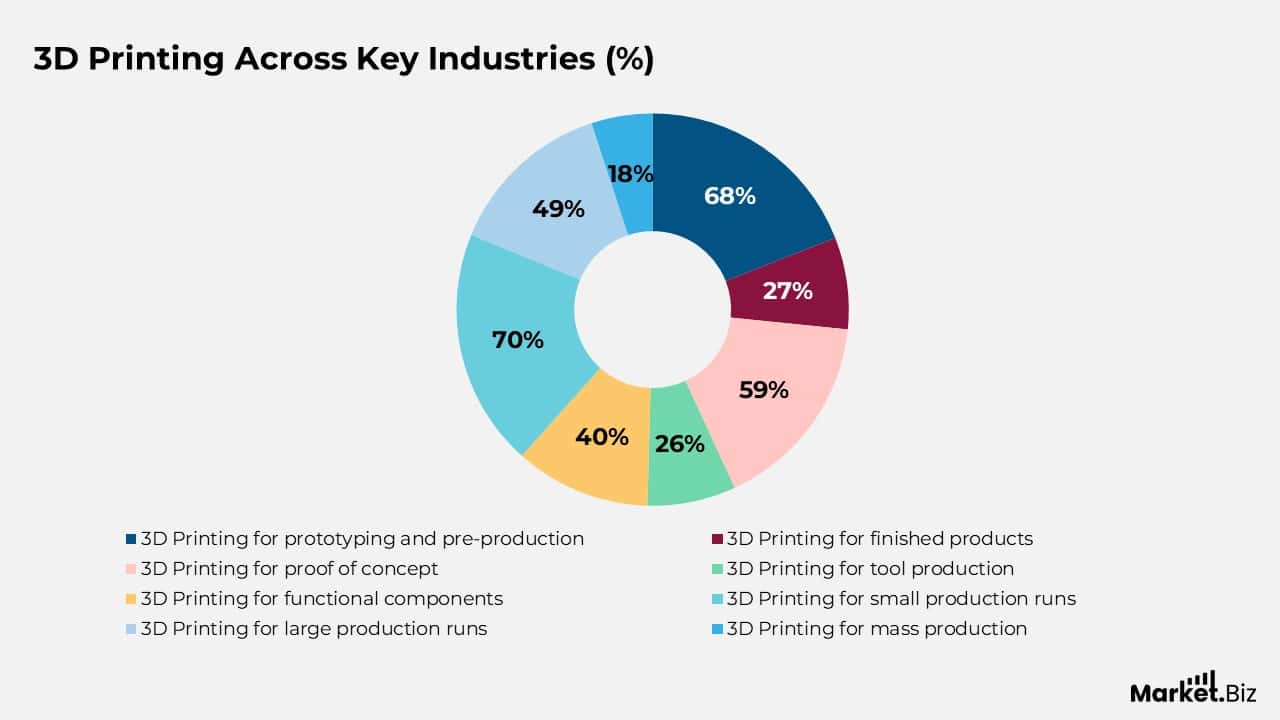
- About 59% of firms apply 3D printing to build proof-of-concept models for product testing and validation.
- Close to 26% of organizations depend on 3D printing to produce specialized tools required for manufacturing.
- Around 40% of companies use 3D printing to create functional parts that can be directly used in finished products.
- Adidas applies 3D printing in large-scale production, especially for the soles of its 4DFWD running shoes.
- Companies that invest more in 3D printing use it for small production runs 70% of the time, for large runs 49%, and for mass production 18%.
- The molds and tooling segment, valued at US$5.2 billion in 2020, is expected to grow to around US$20 billion within the next ten years, showing rapid industrial adoption.
3D Printing in Medical Implants
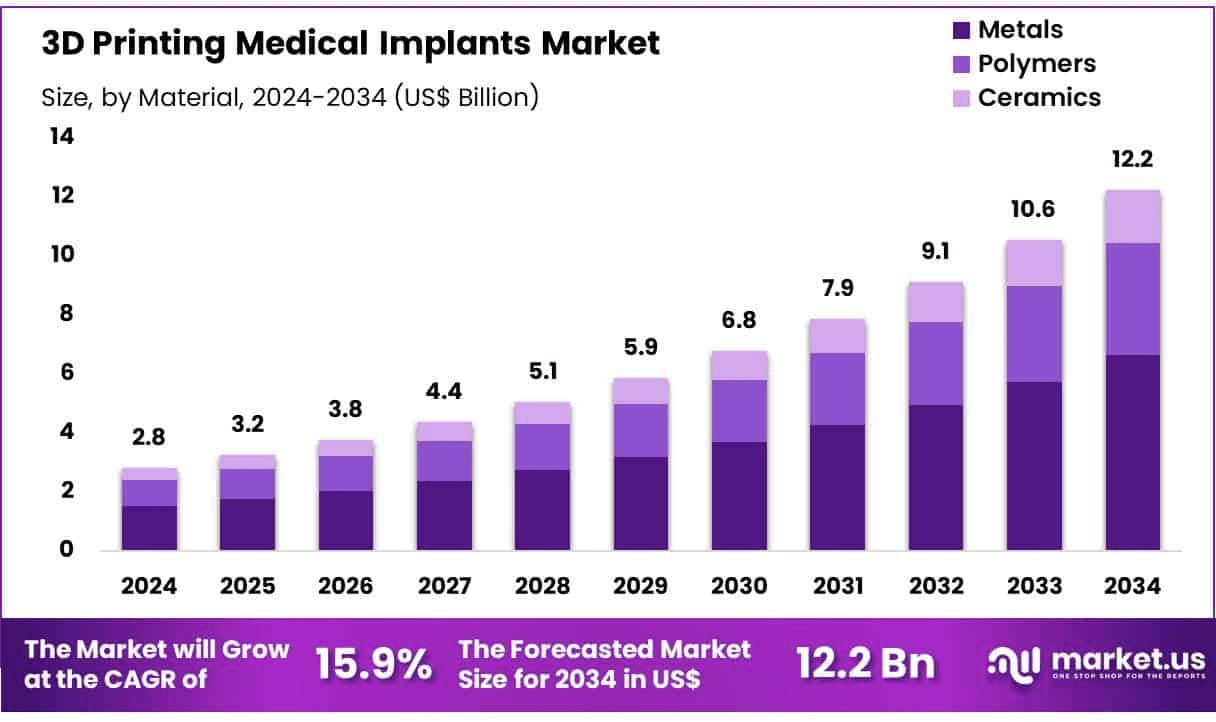
According to Market.us, one of the most life-changing applications of 3D printing is in personalized medicine, particularly the manufacturing of medical implants.
- The specialized 3D printing medical implants market is set to expand from $3.2 billion in 2025 to a projected $12.2 billion by 2034, growing at a steady CAGR of 15.9%.
- This growth is fueled by the demand for personalized healthcare solutions and the technology’s ability to create implants with unprecedented precision and customization, addressing the rising global prevalence of chronic diseases.
- Metal materials (including titanium alloys, cobalt-chromium, and stainless steel) are the material of choice, holding a 54.2% share for their biocompatibility and superior mechanical properties.
- The dental segment is the single largest application, capturing 36.6% of the implant market share by enabling high-precision, patient-specific implants and aligners.
- Laser Beam Melting (LBM) technology is the dominant production method in this space, with a 43.0% share in 2024, recognized for its versatility in producing complex, individualized implant geometries.
- Hospitals and surgical centers are the largest consumers of this technology, holding a 41.8% share, as they leverage 3D printing to enhance procedural precision and reduce overall costs.
Adoption by Industry Vertical
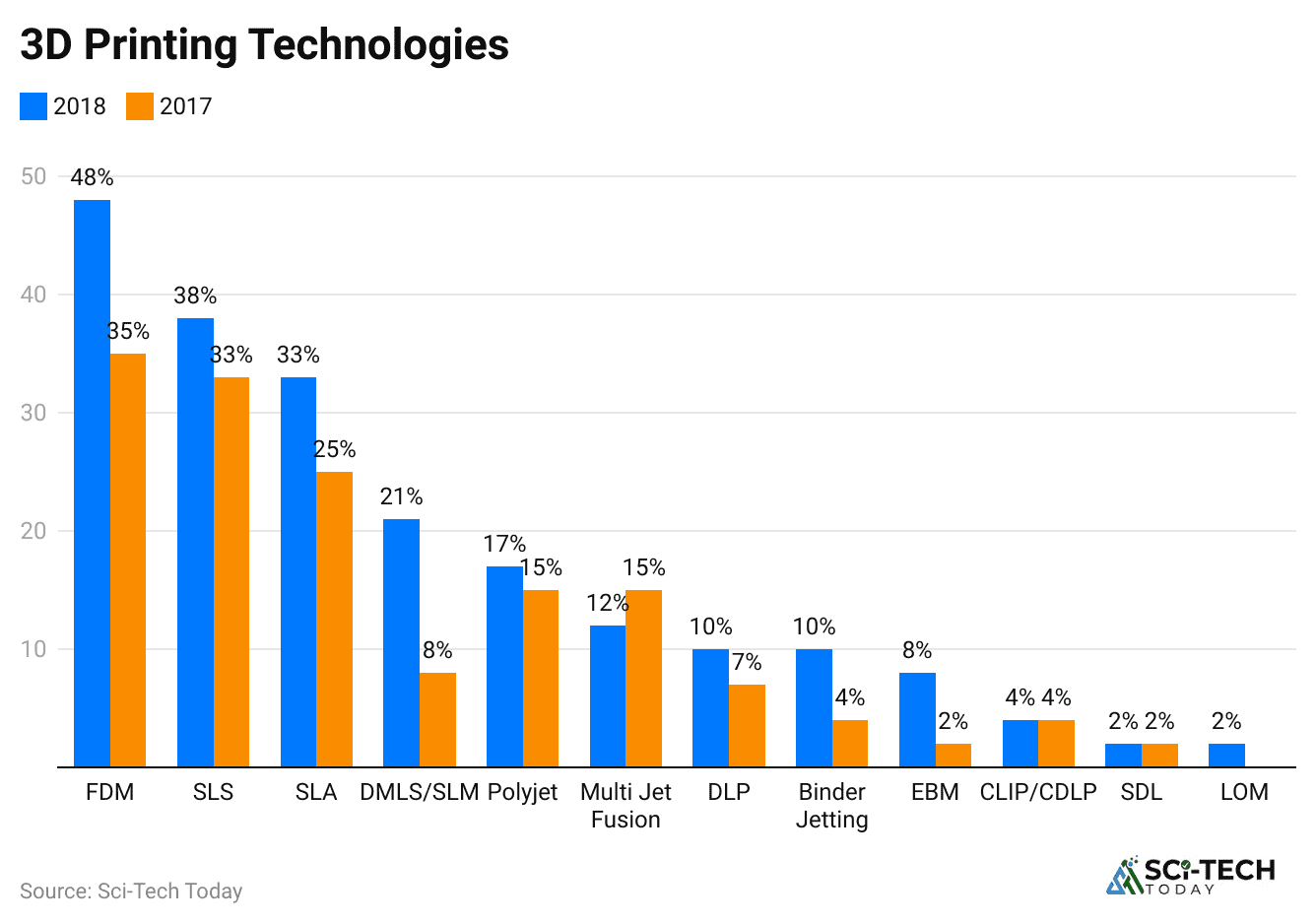
- The global aerospace 3D printing market was valued at $2.71 billion in 2024 and is projected to surge to an immense $21.82 billion by 2033, showing an astounding CAGR of 26.1%.
- Aircraft applications alone accounted for a dominant 65.55% of the aerospace 3D printing market share in 2024.
- Engine components are the largest end product segment, representing a 52.54% share of the aerospace market in 2024.
- The utilization of 3D printing for lightweight components is critical, with examples like Airbus consolidating over 30 fuel system parts into one component, slashing the weight by 75% to improve fuel efficiency.
- North America remains the largest market, generating over 34.84% of aerospace 3D printing revenue in 2024, supported by strong investment from government and defense agencies.
| Aircraft Applications | 65.55% | 18.7% |
| Engine Components | 52.54% | 23.10% |
| Metal Alloys | 60.50% | 25.74% |
Automotive 3D Printing Statistics
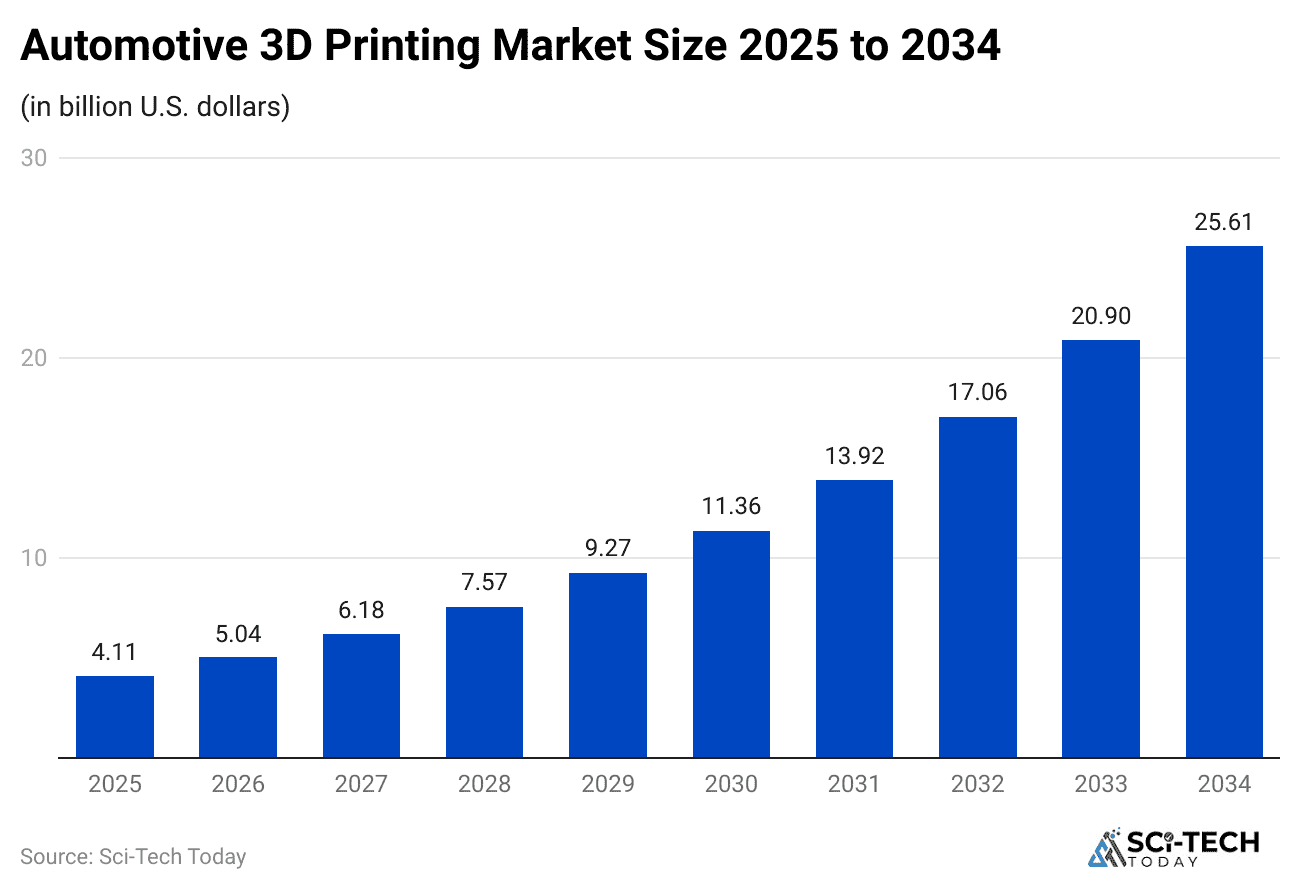
- The 3D printing automotive market was valued at $5.18 billion in 2024 and is expected to accelerate significantly to an impressive $24.94 billion by 2032, demonstrating a strong CAGR of 21.7%.
- The largest application in this sector remains prototyping and tooling, as 3D printing allows Original Equipment Manufacturers (OEMs) to produce test parts in less than a day.
- A key focus is on using 3D printing to create jigs, fixtures, and production aids, which can reduce the cost of creating these manufacturing tools by up to 80% compared to traditional machining.
- The rise of Electric Vehicles (EVs) is fueling new demand, as lighter-weight 3D-printed parts for battery casings and internal components directly increase vehicle range and performance.
- There is a clear trend for high-volume parts, with one major partnership seeing 3D Systems and Daimler Truck AG collaborating to produce nearly 40,000 bus spare parts on demand, resulting in delivery time cuts of up to 75%.
3D Printing in Dental Statistics
- The global 3D printing in the healthcare market was valued at $1.66 billion in 2024 and is expected to grow to a massive $8.71 billion by 2034, with a robust CAGR of 18.0%.
- The dental segment alone is a major force, valued at $3.40 billion in 2024 and projected to reach $10.06 billion by 2030.
- In the U.S. alone, approximately 17% of dentists already use 3D printers in their practice, with this adoption rate having increased significantly in the last two years due to advancements in desktop SLA technology.
- The materials segment is experiencing the highest growth in the dental market, propelled by the demand for advanced.
| Overall Healthcare | $1.66 |
| Dental Market | $3.40 |
| Medical Devices | $3.64 |
Major Challenges and Restraints in 3D Printing
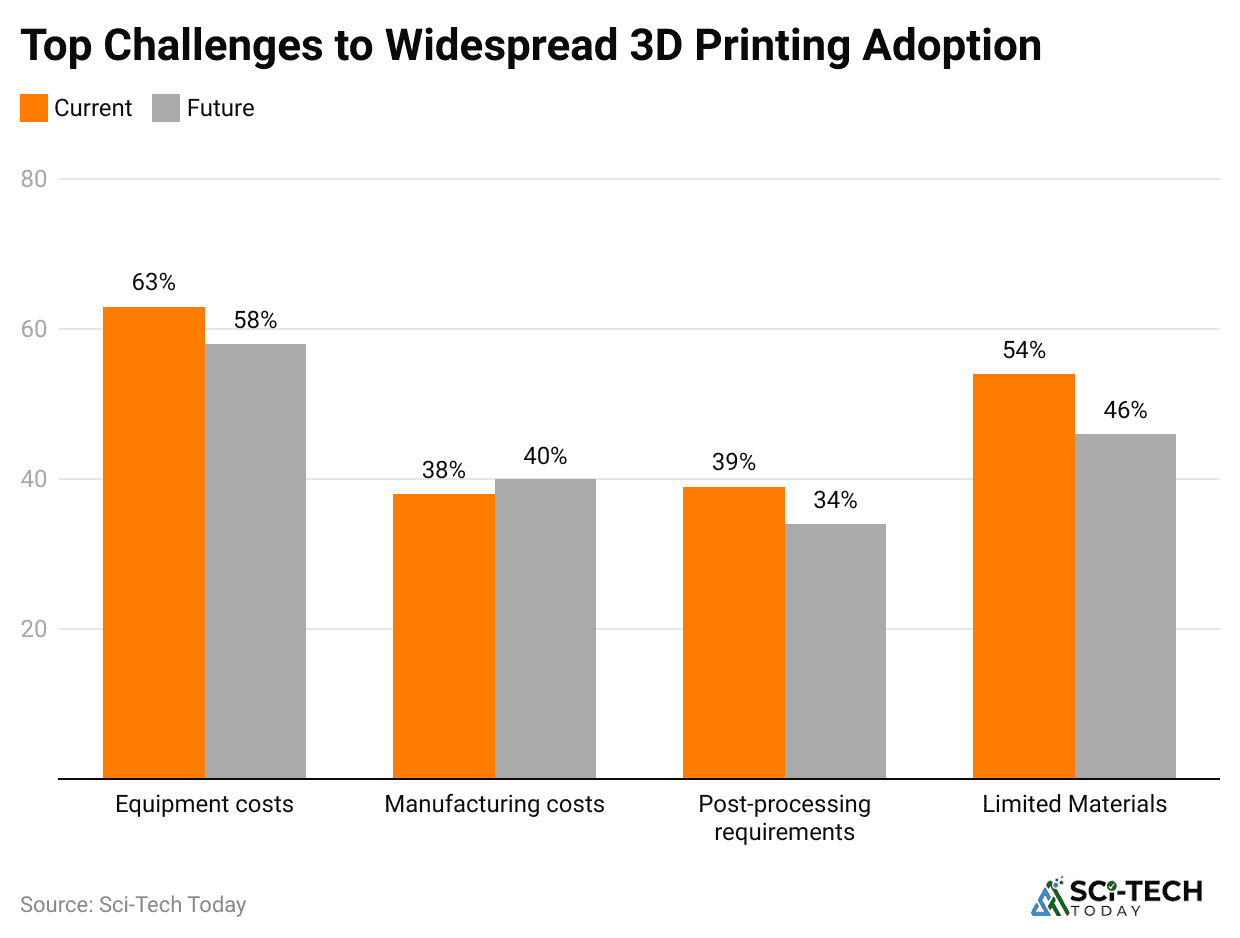
- The high initial capital investment for industrial-grade 3D printers and associated infrastructure remains the single biggest restraint, requiring substantial financial commitment for hardware, specialized software, and operator training.
- A significant challenge is the lack of standardization and regulatory clarity, especially in heavily regulated sectors like aerospace and medical.
- Current 3D printing technologies, particularly for metal, still struggle with high-volume, mass production compared to established conventional manufacturing methods.
- The cost of advanced metal powders remains a barrier, partly due to the small scale of production, though ongoing industry efforts are aiming to improve powder yield rates from the current 50% to over 90% to lower costs.
- There’s a persistent problem of limited multi-material printing capability, as the inability of most current systems to combine different materials in a single build constrains the development of complex, multi-functional parts.
- The industry has to overcome a skill gap, as the complex nature of additive manufacturing requires a workforce with specialized technical knowledge.
- Concerns about material properties and consistency still exist, with manufacturers needing to fully qualify and certify the long-term durability and fatigue performance of 3D-printed parts for critical applications.
Recent Developments and Industry Shifts
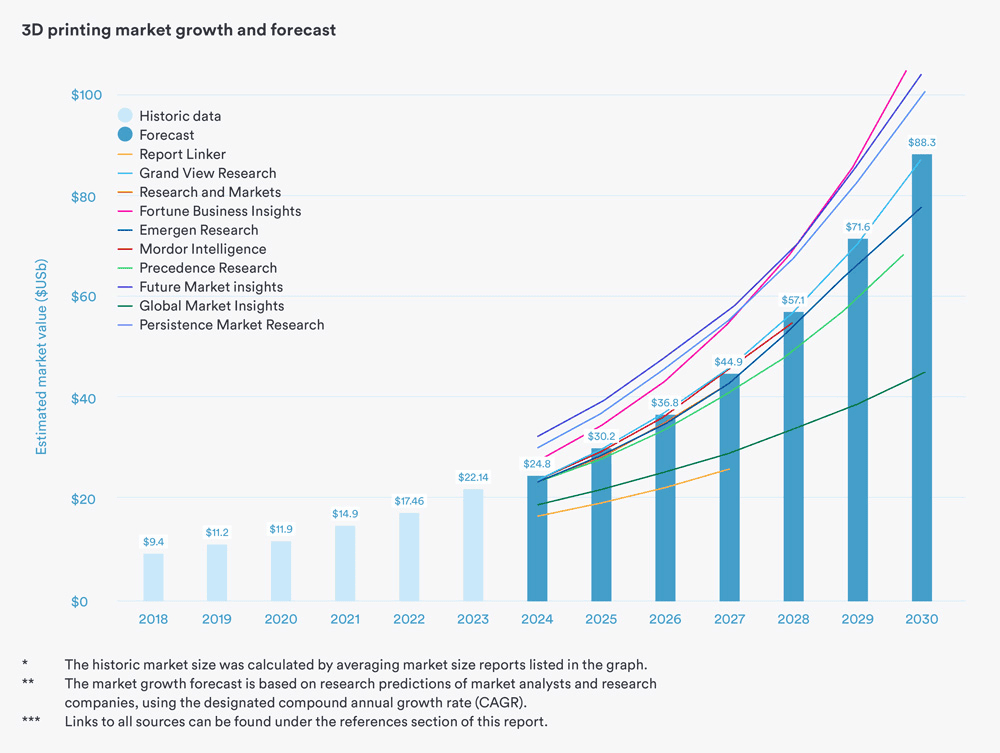
- The aerospace sector is seeing profound advancement, with the average selling price for production-grade metal printers having dropped by 25 to 30% between 2022 and 2024, which significantly lowers the barrier to adopting these expensive systems.
- Shipments of advanced metal 3D printing materials like aerospace-grade titanium powder are seeing major capacity expansions, such as Höganäs AB’s move in late 2024.
- The United States Department of Defense (DoD) has earmarked $350 million for additive manufacturing acceleration in 2024, actively channeling grants to small and medium enterprises to compress part qualification cycles from seven years down to just three.
- There’s a strong trend toward mass-customization, particularly in the medical and dental sectors, where the need for patient-specific implants and aligners is driving massive investment and market growth, now expected to reach over $10.06 billion by 2030 in the dental segment alone.
- The initial barrier of high capital cost is being actively addressed by market competition, with new industrial metal systems launching at prices nearly 40% lower than their 2023 equivalents while maintaining high-quality certification readiness.
Conclusion
Overall, this narrative of 3D printing clearly depicts an industry at a major inflection point, a market size of $18.5 billion in 2024 surging toward $93.7 billion by 2035 with a 20.6% CAGR is evidence of an unstoppable force.
The change from a technology dominated by prototyping to one driving end-use production, especially with metal materials achieving a 24.63% CAGR, is fundamentally changing global manufacturing’s cost and lead-time equations. I hope you guys like this piece of content, if you have any questions, please let us know. Thanks for staying up till the end.
FAQ.
The global 3D printing market is projected to be around $19.33 billion in 2025, and is forecasted to grow at a Compound Annual Growth Rate (CAGR) of 20.6% through to 2035.
Industrial 3D printers were the dominant revenue driver, accounting for a major share of approximately 76.5% of the total printer market revenue globally in 2024.
North America held the largest regional market share for 3D printing in 2024, contributing an estimated 41.39% of the total global revenue.
The Metal 3D printing segment is anticipated to be the fastest-growing material type, with a projected CAGR of 24.63% from 2025 to 2034, driven by high-value industrial production.
Despite the growth in end-use parts, the prototyping application segment continued to generate the most income in 2024, accounting for approximately 70.4% of the total market revenue.

Barry is a technology enthusiast with a passion for in-depth research on various technological topics. He meticulously gathers comprehensive statistics and facts to assist users. Barry's primary interest lies in understanding the intricacies of software and creating content that highlights its value. When not evaluating applications or programs, Barry enjoys experimenting with new healthy recipes, practicing yoga, meditating, or taking nature walks with his child.








